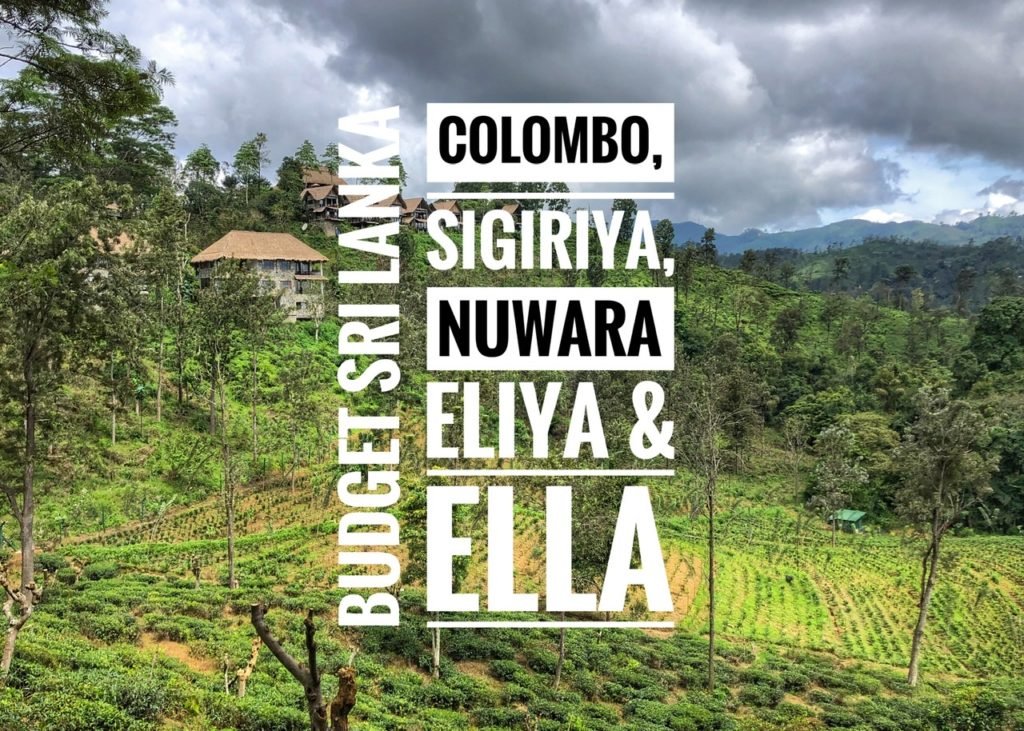
Sri Lanka just may be a country that has it all for a couple of backpackers like us. As we quickly learned, there is lots and lots of reasons it was very aptly named Lonely Planet’s top destination for 2019. It’s inexpensive, safe, has a remarkably good infrastructure for easy and comfortable ways to get around, the climate ranges from tropical to temperate, it’s clean, Sri Lankan society is highly organized and the people remarkably polite… on top of all that there’s plenty to keep anyone busy with beaches, amazing wildlife, rolling mountains and hiking opportunities among natural wonders, tea plantation visits, and colonial and ancient cities and ruins, and of course wonderfully delicious culinary distractions. Like we said, Sri Lanka has it all.
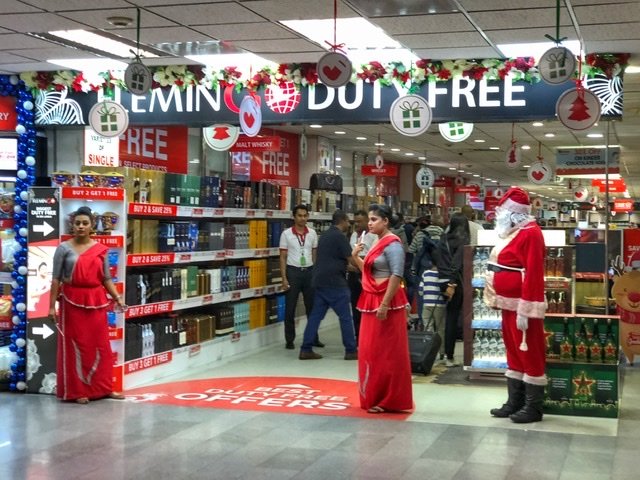
From the moment we stepped off the plane in Colombo we were enthralled…by the smiling customs officials, to the Santa and lady elves surrounded by bursts of Christmas all around, to the ease of ordering and then finding our Uber at the airport, all at the wee hour of 1 am.
A Sri Lankan Customs Poem:
It was the weeks before Christmas and we hadn’t seen a sign. But coming from Maldives, that’s okay, we were doing fine. Then what to our wondering eyes should appear…but Sri Lankans, with Santa and duty free beer!!

Colombo
The capital, Colombo, is remarkably clean and with abundant wide sidewalks and crosswalks… very walkable. The amount of honks and beeps on the street was not even close to headache inducing, and great food was never more than a block or two away. Most people breeze through Colombo, ready to get to the more touristy destinations, but we’re really glad we took three days to properly soak it in. After all, when your first impressions of the capital are this good, you know outside of the capital will be even more phenomenal.

As far back as the 5th century, Colombo was a sea port for trade between Asia and Europe. Starting in 8th century, the city was taken over by the Arab traders, followed by the Portuguese, the Dutch, and the Brits. What is now the center of Colombo’s resurgence where development is happening left and right. The Fort neighborhood was quite literally a fort during the European era and was surrounded by sea on two sides with a moat on the third. This blazing red building was the local retail giant Cargill’s starting in 1906. These ground floor colonnades were once a common feature on buildings to allow people a place to dash under during the heavy monsoon rainstorms.

Spotless clean and well cared for tuk tuks line the street awaiting passengers. We constantly had to fend off the drivers couldn’t seem to comprehend why two foreigners were walking down the street for pleasure instead of enjoying their spiffy tuk tuks. Fortunately, they were always very cordial with a quick “yes, madam/sir. Have a nice day.” For our tuk tuk needs in Colombo we actually relied on UberTuk rather than dealing with haggling or navigating to our destination. We love Uber in Sri Lanka!!

The Pettah District is a bustling bazaar district loaded with everything and anything. It’s probably one of the more frenzied (India-like) places in Colombo and includes the Manning Market, which is bursting with vitamins and colors of every single fruit and veggie sold in the country, including mangos bigger than our hands. This woman sells up to six different kinds of bananas. Talk about a monkey’s fantasy!
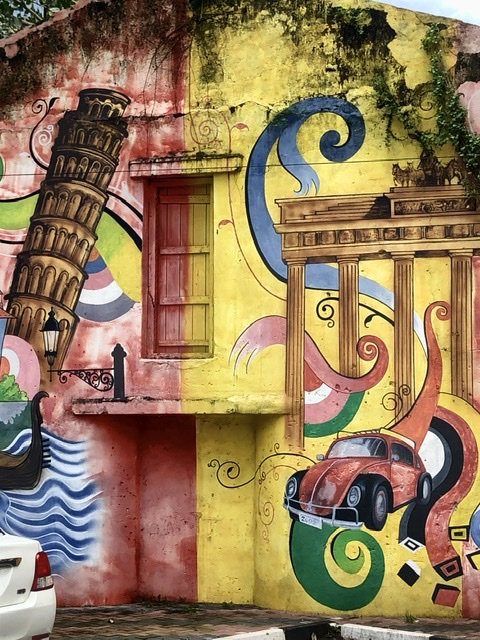
Colorful street art lines some streets. Parts of it had a Central American vibe, which naturally, we adored.

The woodapple fruit we picked up at the market is native to Sri Lanka, and a new one for us. The ridiculously impenetrable brown shell was coconut-like, and very very difficult to crack open. Not having a saw or hammer in our backpacks, Greg went through a process of three different tactics to get in… 1) hammered a knife in it until he got about a half an inch in 2) wedged a spoon into the cut and 3) with brute force cracked a pice off the top of the shell. Once he broke through, it was a mushy, pulpy, fibrous mess with lots of seeds which tasted incredibly tart and a little sweet. A really bizarre fruit. Glad we tried it, and probably won’t again. Although later we found the juice to be significantly more palatable.

The food in Sri Lanka might just be our next “undiscovered” culinary powerhouse. It combines intricate flavors, heaps of exotic spices, and the freshest produce to make dishes that are unique but slightly resemble an Indian meets Indonesian. Like in India, it’s also very easy to be vegetarian here. Some classic Sri Lankan culinary staples…
- Rice+Curry: the standard go-to cheap and absolutely delicious meal served with the perfect amount of spice (it’s rare to find yourself breathing fire as in India.) It’s served with rice and usually 4-6 bowls of a selection of dishes made from curried veggies, meat or fish. These often include: dhal (lentils); mallung (like tabbouleh, this salad combined local greens (like kale), shredded coconut, peppers, and onion; jackfruit curry (the world’s biggest fruit actually has a meaty texture and combines beautifully with rich curry sauces, and papadams (a crispy chip like snack.)
- Kotthu: chopped roti (a thick flatbread) with veggies or egg, cheese or meat on a hot plate. Served with spicy sauce, onions and tomatoes on the side. Absolutely divine. Mandy’s fav. Wash it down with a cold Elephant brand ginger beer…even better 🙂
- Masala Dosa: a typical South Indian staple consisting of crepes made from fermented rice and lentils, accompanied with sides such as sambar (a tangy lentil soup with vegetables) and various kinds of chutney (coconut, tomato, tamarind, mint).
- Egg Hoppers: bowl shaped pancakes made from rice flower and coconut milk. An egg is tossed in the middle. Sooo yummy!
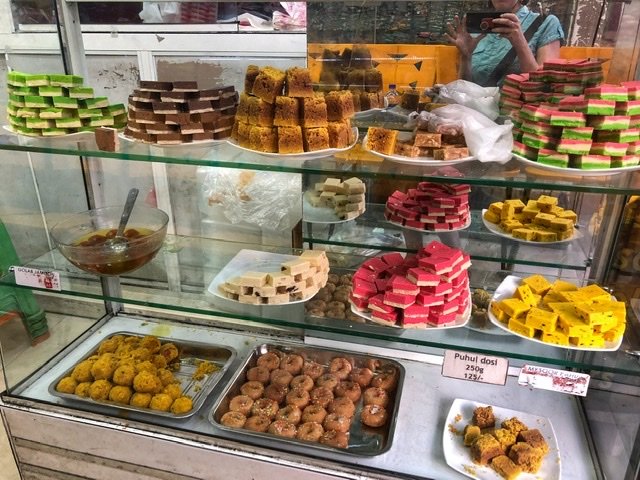
Sri Lankan desserts…and yes, there’s some Indian influence for sure!

Sri Lanka is the first place in the world where we’ve seen gorgeous Islamic mosques, alongside beautiful Hindu temples, and malls bedecked with Christmas trees. These three minority religions make up 30%.


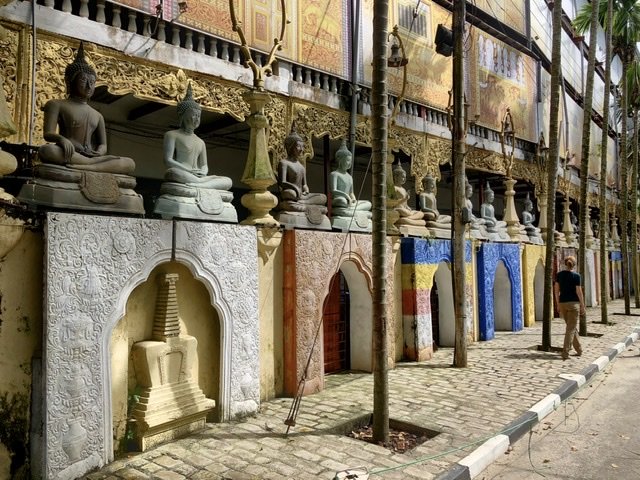
In the meantime, Buddhists make up the 70% majority. Buddhism arrived from India in the third century BC transforming some of the oldest settlements and creating what is now Sinhalese culture. The other ethnic group, the Tamils, arrived much later from South India. There have been many ethic tensions through the years including a recent 25-year civil war which ended in 2009.

The Galle Face Green is Colombo’s front porch. A place where locals (and tourists!) congregate every night to watch the sunset, fly kites, socialize and have dinner among the many street food stalls. Our first (and best!) kotthu was here at Nana’s (pictured earlier.)

The mangoes were massive, juicy and inexpensive. Finally. We arrived in a country where they seemed to be in season!

A flower market on the side of the road.
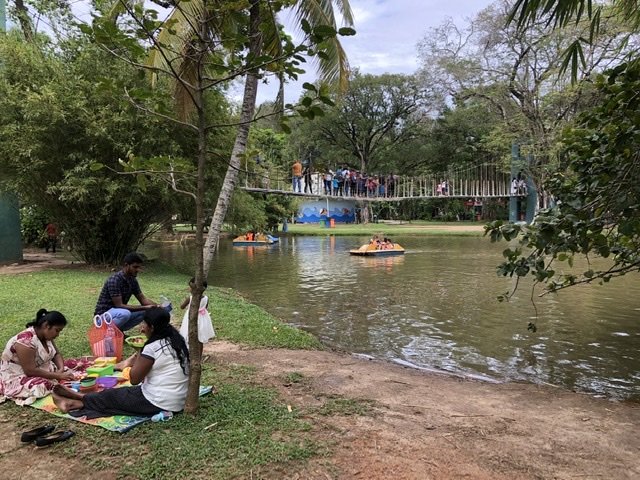
The parks in Colombo were just lovely and packed with people and picnickers using them for leisure. We saw paddle boats, workout facilities, runners, dynamic modern playgrounds and vendors of all kinds. It was wonderful to see this level of organization and cleanliness.
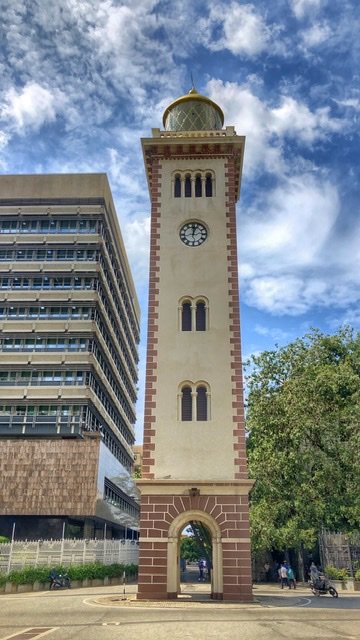
The light on the Old Colombo Lighthouse was sadly deactivated in 1952 when the development of nearby buildings obscured its view of the water. It’s now just used as a clock tower.

We love seeing little slices of Americana redeveloped for the local markets. Mmmm.

One thing you’ll never find in the States… Greg eating durian ice cream. Can’t believe he actually ordered this. More on durians later in the post!
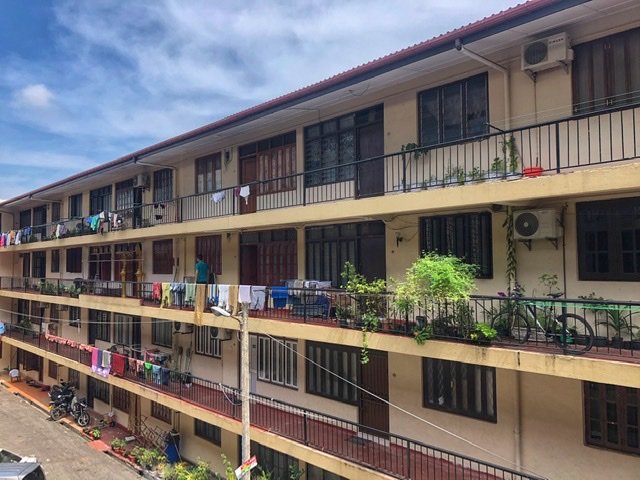
Where we stayed in Colombo…a local apartment complex block from Airbnb for $9/night. It was nice to have our own kitchen again.
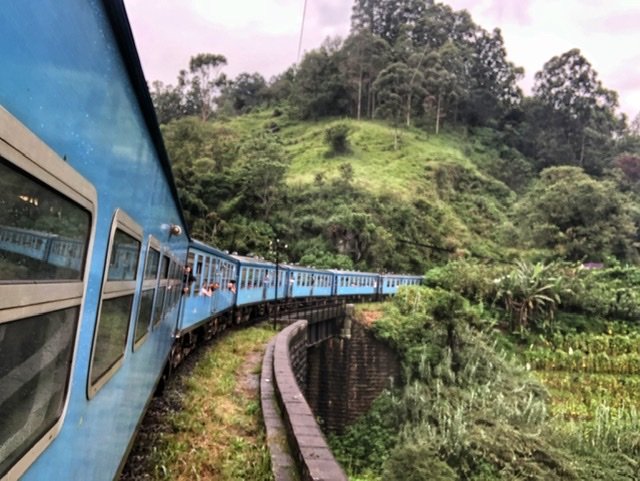
Travel in Style in Sri Lanka
In Sri Lanka sometimes the journey really is the destination. One of the things that made us really fall in love with Sri Lanka was that the ‘fun’ parts didn’t just wait for us at whatever next destination we had marked on our map. In some of our more recent travels these ‘getting around’ from point A to point B bits had become one of our most dreaded ‘next steps’. We are happy to report, getting around in Sri Lanka is something to look forward to…and super cheap!! As an unexpected bonus, real actual sidewalks are also commonplace in Sri Lanka’s cities which even made walking a pleasurable transportation activity.
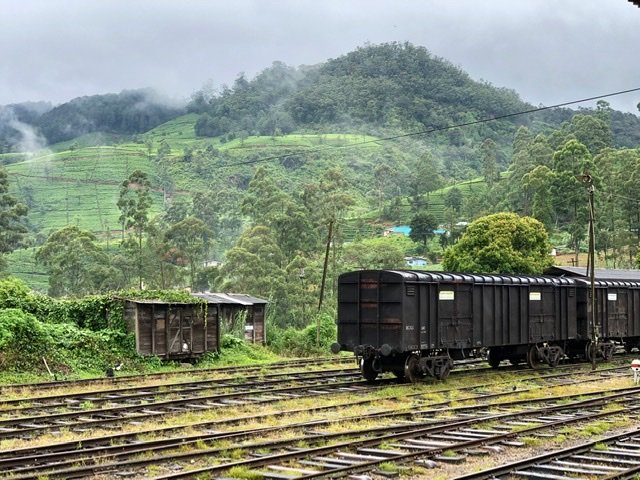
The gorgeous green rolling countryside around Nuwara Eliya just begs you to ride the rails and admire.
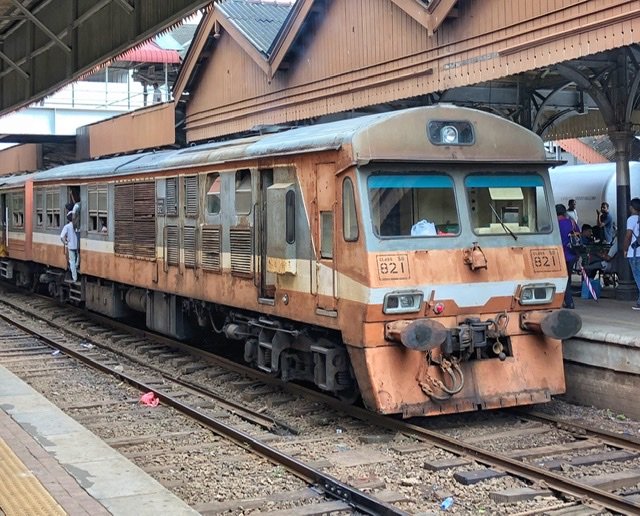
A local train engine. Riding the train in Sri Lanka is like every other form of transport we’ve highlighted. Fun! This engine may look a bit haggard but don’t let that dissuade you from hopping aboard… you’ll get great scenery, friendly locals and vibe, helpful conductors, and just the kind of old world Asian train experience you’ve been craving.
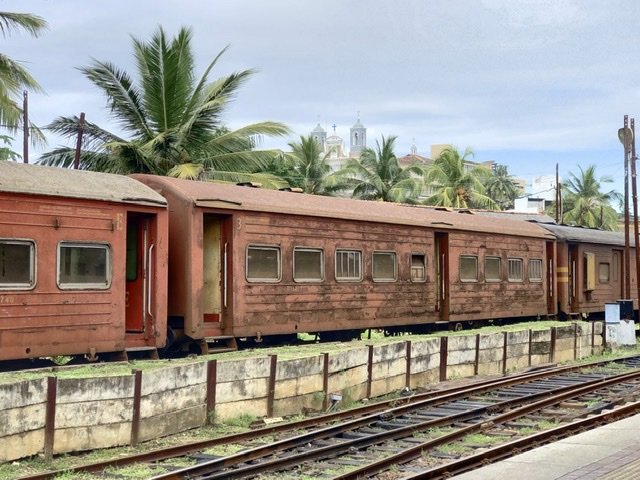
No, these carriages are not still in use for passengers. But they still look adorable in their disused state. Riding the rails in Sri Lanka still carried that romanticism of a bygone era… we just loved every bit of it!
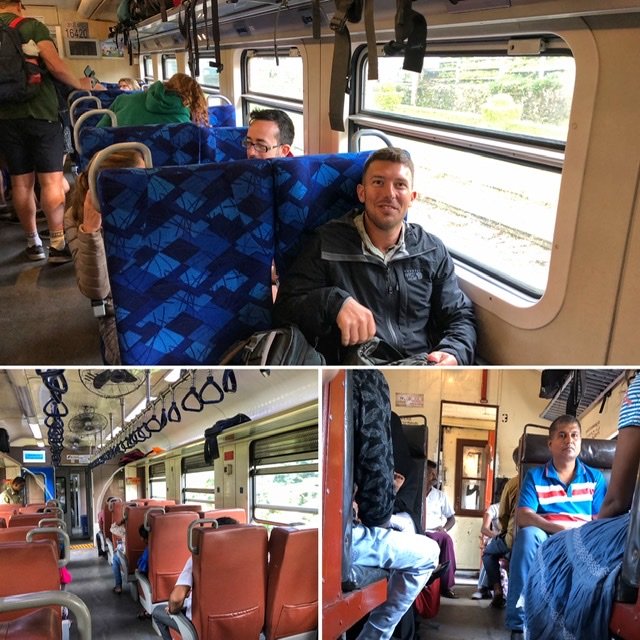
Traveling by train, the carriages come in three classes: 1st, 2nd, or 3rd. The biggest differences between them besides cost being, seat quality and availability, ability to make reservations, and window type. (Tickets from $1-$5.50/each.) As you can see from the pictures, none of the classes look uncomfortable or scary. And, we can say that after testing all three classes we enjoyed all of them. It’s a good idea though, if you’re traveling more than a couple of hours and want a guaranteed seat you should get the reservable 2nd or 1st class seats.
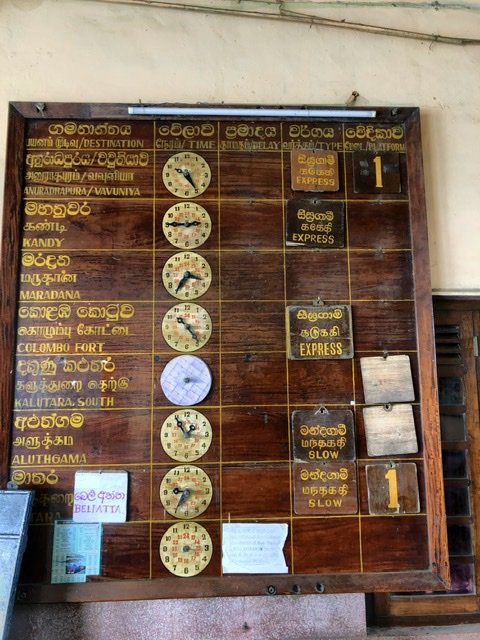
Buying a ticket is easy too, Sri Lanka was so incredibly organized everywhere we looked there were signs (in English) giving information or directions. This sign is a beauty! Greg must have stood admiring the craftsmanship, patina, and organization in this sign for a truly inordinate amount of time.
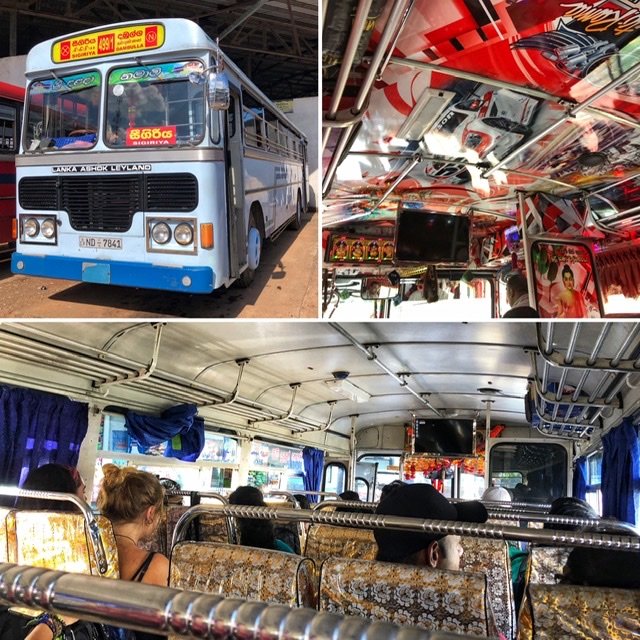
Even the local busses exude fun! Totally blinged out and spruced up with chrome, flat screen TVs , surround sound music systems bumping music videos via the flatscreen TV, flashy glittery vinyl seats, and ceilings covered with dramatic sticker murals! And above all, they are c-l-e-a-n! Every bus has a conductor to help get you on and off, pay your fare, and tell you where you need to get off or transfer to. They still try to pack the busses with people, and some can drive a bit too fast, but no one is forced to sit on the floor like elsewhere and as soon as a seat becomes available the locals let you know to grab it! (Rides were from $.25-$.80/each, including long haul rides.)
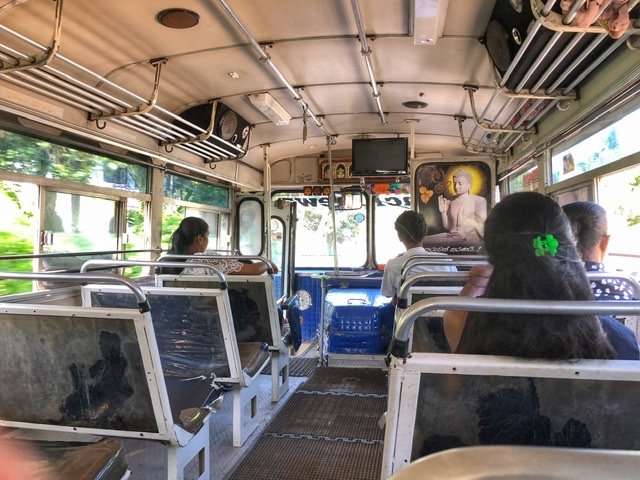
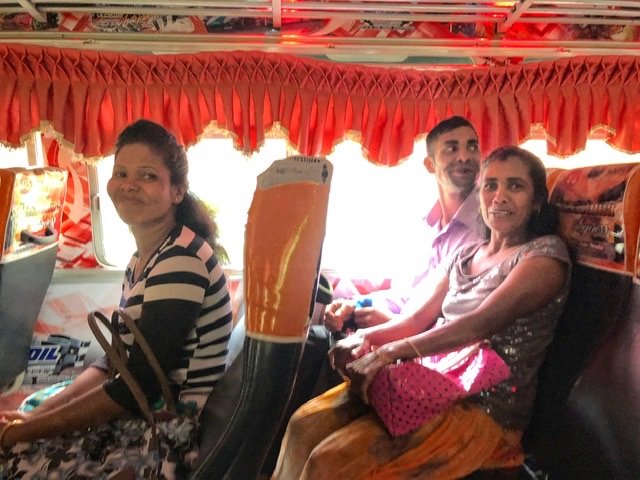
The instant friends we made from across the aisle way. From the moment we sat down they couldn’t resist smiling at us, and excitedly welcoming us to their country.

In Sri Lanka they are constantly putting their best foot forward to their foreign “guests.” At some train stations you will find separately labeled facilities for foreign travelers, like this “foreigner rest room” in Nuwara Eliya or a “foreigner toilet” which are remodeled or spruced up spaces that might meet the ‘foreigner’s standards’. By the way, counter to assumption that these facilities are exploitive and fee based… they’re not. This plush foreigner rest-room was free to enter and hang out in for anybody and the foreigner toilets only required a nominal upkeep fee or were free too.

Tuk Tuk. No only is it fun to say, “tuk tuk”, but in Sri Lanka fun to take, tuk tuks. In Colombo there is even an UberTuk service! We took dozens of tuk tuk rides in Sri Lanka (also Tanzania, Ethiopia, Nepal, India, Thailand…) and in Sri Lanka they were hands down the nicest drivers, and the most clean and well cared for tuk tuks we’ve experienced anywhere. What’s better, they are very reasonably priced but you can still bargain if you want to save more. An average ride is between $1-$2.
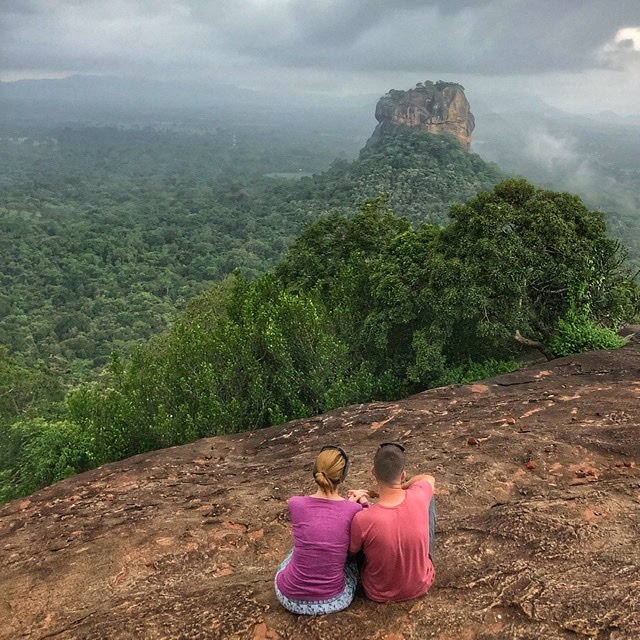
Sigiriya & Dambulla
It was time to venture inland from Colombo and Sigiriya would be our first stop after a 6-hour train ride. The UNESCO world heritage site, Sigiriya, is best known for its giant rock formation that juts up like a shark’s fin protruding obtrusively from an otherwise relatively verdant jungle canopy. While there, we also visited a 2100-year-old Buddhist cave temple, enjoyed an authentic Ayurvedic head treatment, and dodged our way around wild elephants to get back and forth to our fabulous guesthouse, at Sigiriya Danu Homestay.
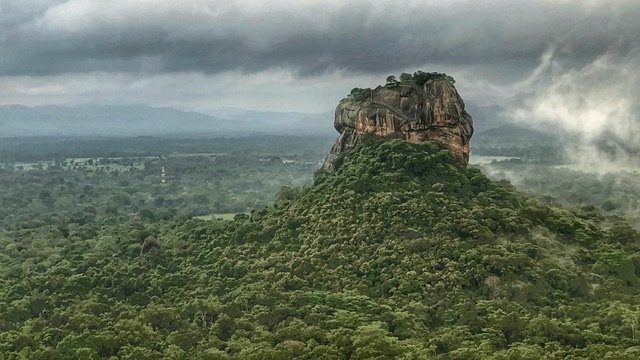
Most people come to Sigiriya to see this rock, which is truly a natural phenomenon jutting from nowhere. It towers 200 meters above the surrounding countryside and was once a medieval capital of Sri Lanka. Sigiriya literally translates to Lion’s Rock. There is a staircase leading to the top which passes through two huge lion paws and the remains of a gigantic lion statue which gives the rock its name. It costs a whopping $30 per person to climb to the top. However, from the top you obviously don’t get this view.
Instead, we opted for the $2.50 ticket which is the cost to climb nearby Pidurangala Rock. It’s highly recommended to start at 5:30 am to do the sunrise hike (which we did, although the sun seemingly never rose on this quite overcast day.) On the ~25 minute climb up, you’ll pass by a cave temple built in 5th century BC with a lying down Buddha. It’s a relatively easy uphill climb until the last five minutes which is purely scramblicious… ducking under and scrambling over multiple boulders.
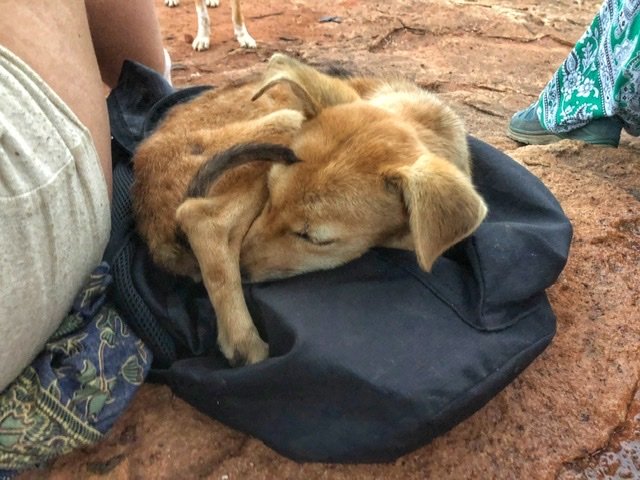
During this bit, we encountered a trapped stray dog, which was so sad. Especially when we saw all the dogs and puppies at the top. Fortunately, mama dog eventually managed to work her way out and all was well.
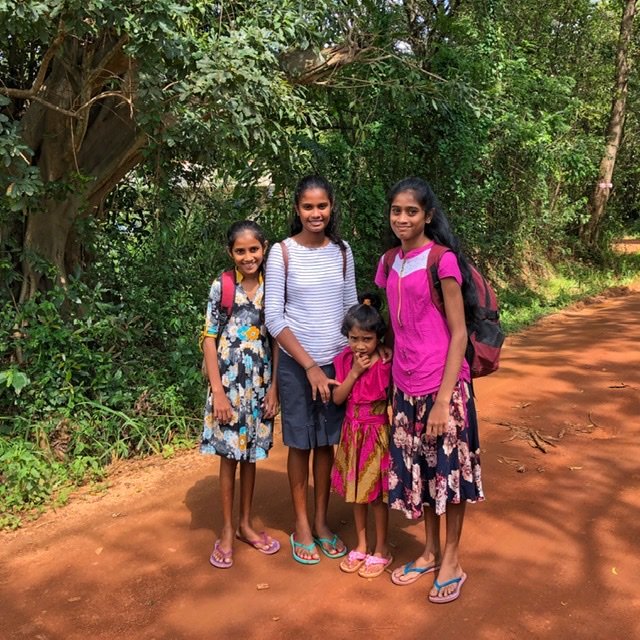
Some local girls we met on our walk into town.
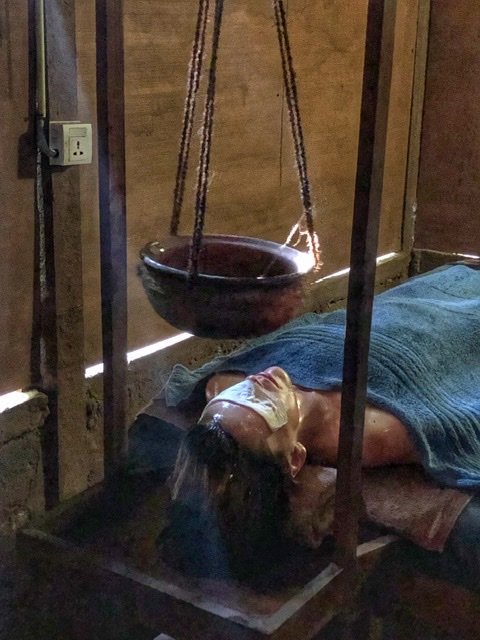
Mandy experiencing her first Ayurvedic Shirodara-an oil head treatment in which a thin stream of warm oil (made of “a bunch of jungle herbs and spices we won’t know the translations for” as told to us by the spa) was poured on her head in a steady stream. ($8 for 25 minutes.) It’s supposed to provide mental and spiritual relaxation and help with headaches, insomnia and depression. It was a bizarre, and yes, very relaxing feeling. It felt like every single hair follicle was getting a head tickle as the oils dripped down and saturated the entire scalp. Also, Mandy experienced a white light in the center of her forehead during the treatment. It felt as if her entire third eye chakra was releasing temporarily. Wow…

Taking a day trip to Dambulla, we visited the oddly kitschy Golden Temple. A nearby sign claims this Buddha is allegedly the tallest Buddha in the world at 100 feet (30 meters) although in fact, it’s not even the biggest in Sri Lanka ? There is a Buddha four times taller in China which actually claims the Big Buddha prize.

At the Dambulla Cave Temples. In total, there are five caves, used by man since ancient times. Within these caves, starting in 1st century BC, there are man-made Buddha’s carved out of solid rock and you can even see traces of gold gilding one of the Buddha’s. The ceiling and wall murals are some of the finest and most well preserved in Sri Lanka which show scenes of Buddha’s life. They certainly struck us with a sense of awe.
We learned that there are six positions that Buddha sits in…blessing, teaching, 1st meditation, 2nd meditation, sleeping and dead. You can only tell the difference in sleeping and dead by the position of the feet. If the feet are lined up perfectly, he is sleeping. If they are slightly askew, he is dead. The Buddha’s behind the sleeping Buddha are both teaching. The sitting Buddha’s in this photo represent 2nd Meditation. (Hands face-up, stacked on lap.) It gives you a new appreciation of the statues once you understand these basic poses. Many of these caves were lined with dozens of statues all in these various poses.

Remember Pidurangala Rock? Well, it was only fifteen minutes from our place so we had every intention to walk. However, Danu, our guesthouse host, highly recommended this was a bad idea. There are apparently wild elephants in Sigiriya that have been known to charge humans after dark or at dusk. So, Danu…being the amazing host he is, offered to drive us for our sunrise walk waking up at the ridiculous hour of 4:30. It was so kind of him. Sri Lankan hospitality seems endless. They are absolutely some of the kindest, genuine people.
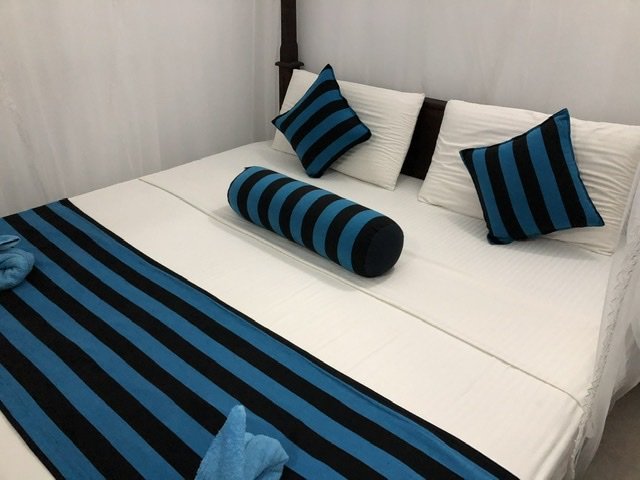
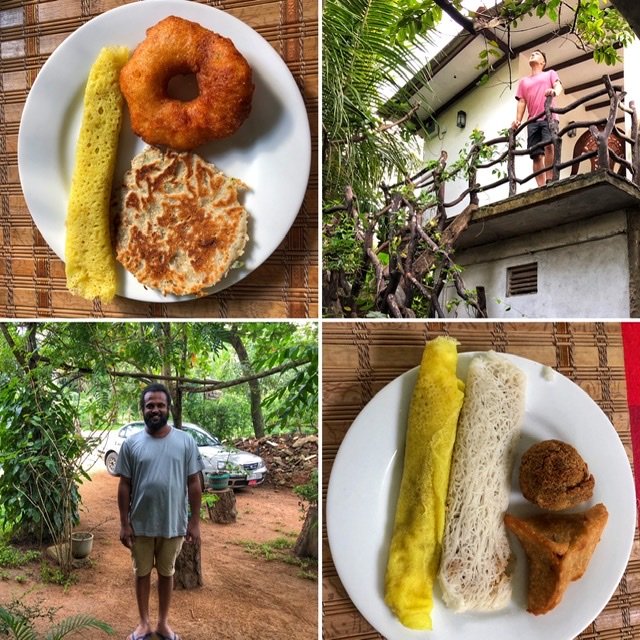
By the way, this is Danu and his place, our amazing homestay host where we had a very comfy bed, high speed internet, private bath with hot water and our first introduction to the wonders of the Sri Lanka breakfast. ($16/night.) If you want amazing value and a wonderful place to stay, contact Danu on What’s App at +94774642805. He also does tours around the area.
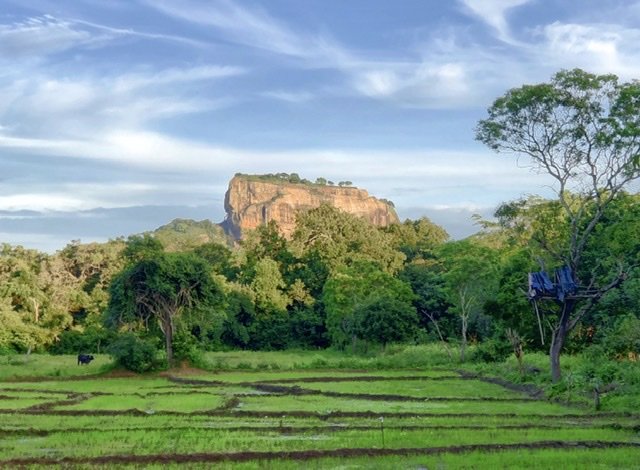
Sigiriya from near Danu’s place.

The monkeys in Sri Lanka are no less dubious, cunning, nor totally adorable than their close relatives in India or Nepal. Mandy battled her emotions, and Greg’s “Mandy, don’t feed the animals” park ranger warnings, not to toss a solemn beggar a banana at breakfast.
Nevertheless, she did, and it was beyond hilarious to watch the cheeky little monkey shimmy down the tree, and slyly slink an arm out from the bushes to deftly grab the coveted banana and dash away in the blink of an eye.

Nuwara Eliya (Little Britain)
Leave it to the British (in the early 1800’s) to be the first to settle and build a town in the coldest, wettest and gloomiest place they could find on an otherwise lovely temperate and tropical island.
At 1,868 m (6,128 ft), visiting the town of Nuwara Eliya feels as though you’ve been transported from Sri Lanka to the UK. It’s bizarre. For the homesick Brits, the cold and rain soaked land must have truly struck a familiar cord making them long for the motherland. Nuwara Eliya was essentially made into an 1800’s little Britain, and it has largely managed to stay that way.
Grand British styled homes and stately mansions are peppered all around town, along with traditional English style gardens, a golf course, and of course… tea is king.
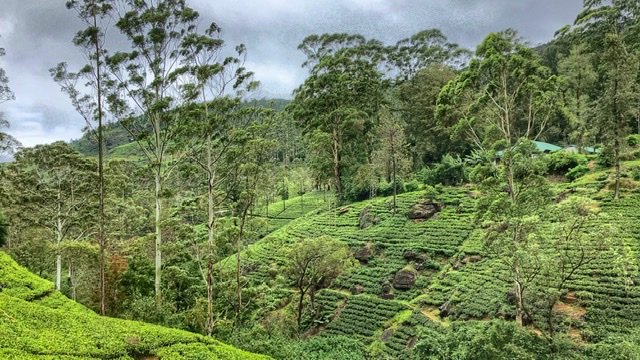
As the center of Sri Lanka’s Ceylon tea growing industry, alluring emerald tea plantations have been carved into nearly every patch of rolling terrain, while waterfalls drop gracefully off the saturated hills, and in December Christmas lights glow to and fro. We were only reminded we were in Sri Lanka because of the shade of the people, the tuk tuks and glammed up busses zipping about, and the Buddhist stupas that dot the town.
To get to Nuwara Eliya we hopped on a local bus from Sigiriya (changing buses in Dambulla and again in Kandy) and costing a grand total of $3.70 for both of us…for the five-hour journey through truly striking hill country scenery.
This was our first longer distance bus journey in Sri Lanka (we’re still a bit weary of bus travel after our harrowing journeys in Nepal), but we quickly found bus travel in Sri Lanka to be easy, even… borderline enjoyable. First off, there are actual identifiable bus stations, secondly it was incredibly easy to find the busses we were after at the stations, and then finding an open seat was no problem. The busses were timely, user (or foreigner) friendly, people helpful, and most importantly organized. Wow! The Sri Lankans are certainly organized! Also, bonus points go to the busses since they play their local music at pleasant volumes, AND the drivers drove at a non-life-threatening pace while honking the horn only as needed.
Something else happened on that bus ride besides a change in scenery. The weather. In Sigiriya it was a very enjoyable 24 degrees (75F), but in Nuwara Eliya it plummeted to 10 degrees (50F) with a completely overcast sky and drizzle-in-your-face rain. Welcome to Britain in December, but with tuk tuks.

Fortunately, despite the crummy weather, there are lots of good reasons to visit Nuwara Eliya, including nearby incredible waterfalls. Pictured is Ramboda Lower Falls.

There is also a center and upper Ramboda falls in this area. Despite the chilly temperatures, we witnessed some daring adventurers (probably Brits) braving a swim in the upper cascades!

On this same day trip, we also visited the Damro Labookellie Tea Centre and Garden. Big points for this particular factory… it’s completely FREE to visit and take a tour (other nearby Tea Plantations charge up to $16!!) The tour (which we tipped our guide a $2 for), includes a tea tasting of nearly 20 tea types, and (incredibly!) a free full pot of delicious tea to sip on along with a lovely view over the plantation grounds. To accompany our tea, we also couldn’t resist splurging(??) on two giant pieces of chocolate cake for $1.20.
On the tour we learned some remarkably interesting facets about the tea harvesting and manufacture process.
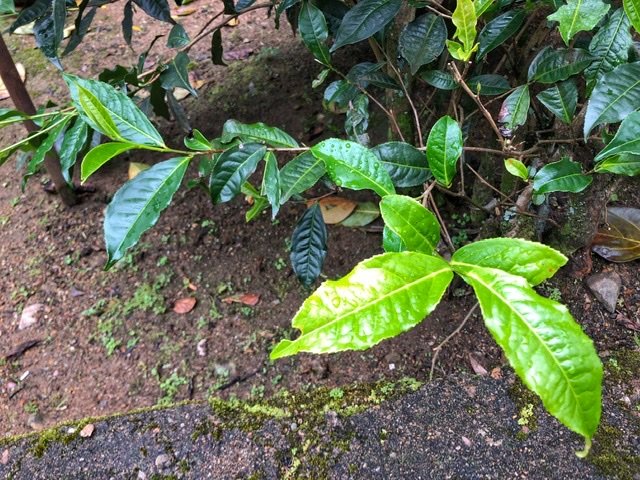
A close up of the tea plant leaves. Leaves are hand picked by “well trained female hands” which are “gentle enough” to “handle the plants with agility.”

As soon as the leaves are received at the factory, it is weighed and spread on troughs for drying. Withering, or drying is a process, where conditioned air is circulated between the leaves, initially to remove any surface moisture and thereafter to concentrate the tea juices. It takes 10 hours to 14 hours.
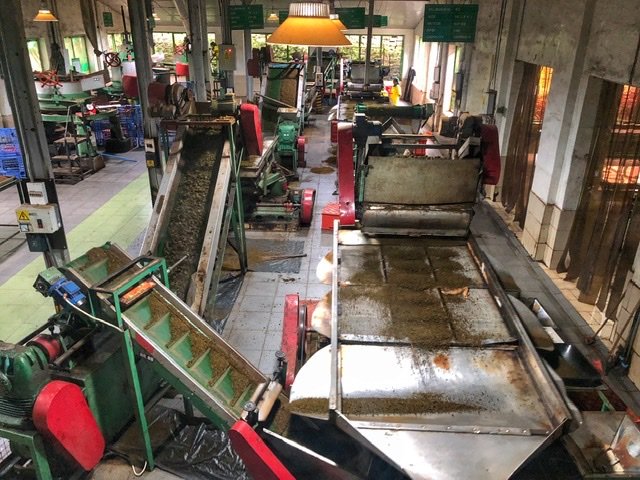
Next the leaves are put in rolling machines which twist the leaf cell walls to bring the juices to the surface of the leaf. This process takes about 20 to 30 minutes.

The rolled leaves then pass over a roll breaker to separate the twisted leaf from the untwisted, and to reduce the heat build up.
Then they are fermented. The fermentation can bring out the flavour, strength and the colour of the liquors and infusions. Fermentation is generally carried out on glass or tiled tables. Black teas are fermented much longer than green teas, which is also what gives them more caffeine.

Next is the drying process, which stops fermentation. The fermented leaf still contains from 45% to 50% moisture. The leaf is passed through yet more driers. This drying process takes about 20 to 25 minutes and reducing moisture to about 2-3%.

Tea leaves are then graded / sifted according to size and shape and packaged.

It was then time to taste the teas! From blacks, to whites to greens to oolongs, we had never tasted so many varieties. The tea tasting process was interesting too, a spoon is dunked in a cup of tea then poured into your own personal tea tasting shot glass for evaluation.
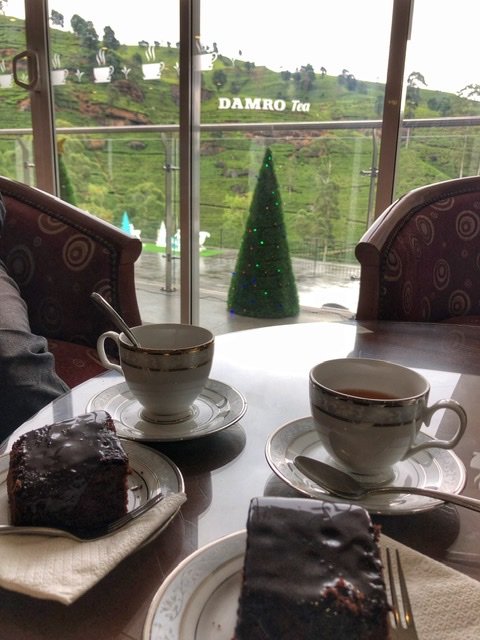
Enjoying our tea, cake and view. What a fun day!! And it cost next to nothing!

After the “gentle female hands” pick the tea leaves, they give them to the man hands who (probably) less gently smoosh them while packing and carrying them to the factory.
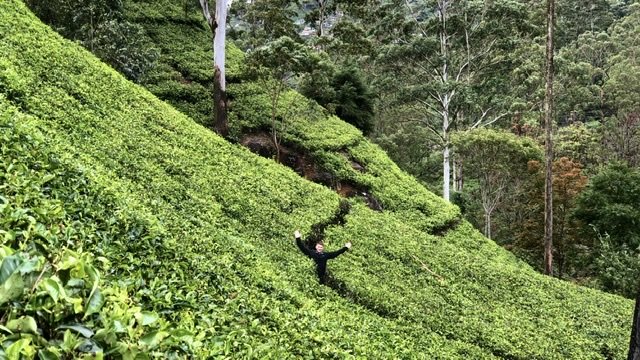
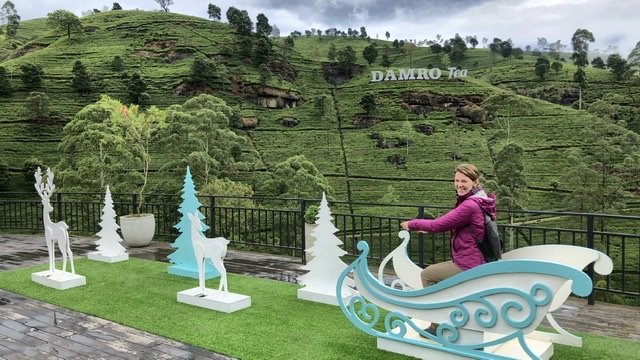

Exploring the tea plantation after our tour.

Our home in Nuwara Eliya for three nights…UYou Guesthouse ($16/night) which was interestingly run by a Chinese lady from afar and her local “Lanka boy” assistant. We were, oddly, told the “Lanka Boy” does not smile (but nothing is wrong with him.) At UYou we got the cozy loft unit below the roof which allowed us a nice view of the pounding deluge outside as well as the thundering drops on the tin roof. This did not help in motivating us to venture out and explore.

Strolling through Little Britain and the immaculate gardens of the massive and historic 1864 Grand Hotel which was once the governor of Sri Lanka’s house. Not too shabby. Bookings start at around $200/night.
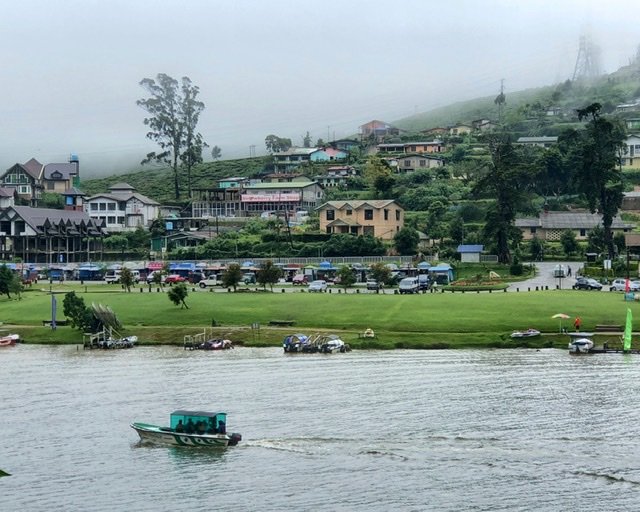
The other view is Gregory Lake, a manmade lake which was created to give the English residents a place for boating activities or water sports.
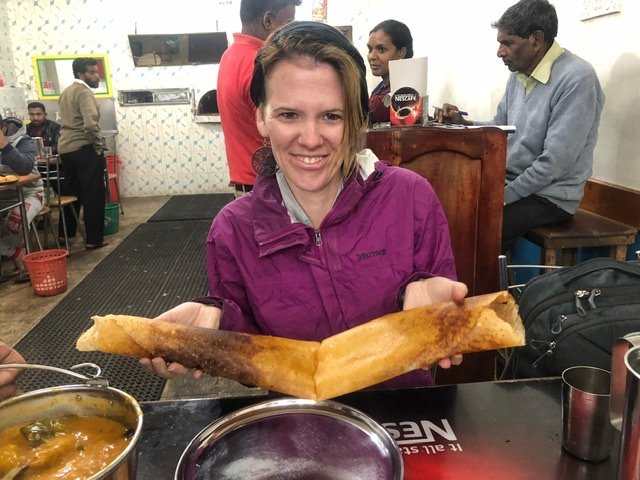
Stopping for a masala dosa snack. Was not expecting it would be bigger than Mandy’s thigh.
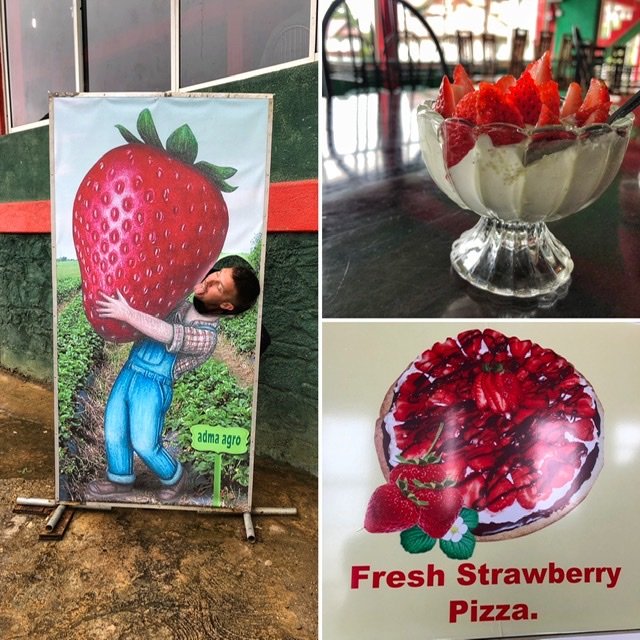
Another absolutely fantastic addition to Nuwara Eliya by the British was strawberry cultivation. They of course new the cooler weather meant the perfect climate for growing them. We did not expect to be eating delicious strawberries anywhere in Asia, but here they are, in Sri Lanka. And even better, it’s a tourist attraction! Visiting the Adma Strawberry Farm, indulging in a strawberries and cream dessert, and doing our best to ignore the strawberry and chocolate pizza on the menu.

Ella: The Gem of Hill Country
If you ask fellow Sri Lankan travelers or locals to name their most beloved place in Sri Lanka you’ll likely hear “Ella” as their response. Ella is a renowned tourist hot spot and good for all types of travelers, from budget backpacker to luxury. The weather is temperate and comfortable year round and it’s surrounded by lush green mountain scenery with walking trails, dancing waterfalls and wildlife. There are also lots of day trip options in the surrounding areas including one of the world’s top historic train routes, and plenty of room for everyone with innumerable guesthouses, hotels, hostels, and resorts. The main street through town is also loaded with more than enough quality restaurants/bars and other resources to make your stay effortless and enjoyable. We agree with everyone who urged us to visit, Ella is worth the hype, and an unmissable emerald gem in Sri Lanka’s Hill Country.
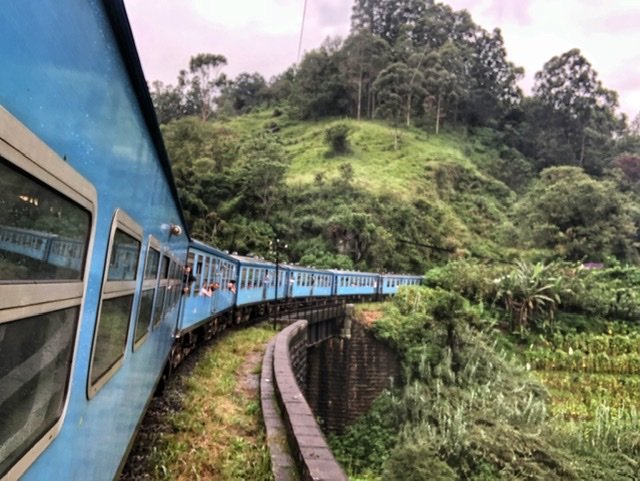
Speaking of, train travel is a must in Sri Lanka, certainly starting with the iconic train ride from Nuwara Eliya to Ella. The train ride getting to Ella has been acclaimed “one of the prettiest train rides in Asia” by numerous websites, guidebooks and writers. Unfortunately, our train journey was during a torrential downpour which shrouded the hills in thick mist and low clouds. But, what we saw of the impossibly green landscape between the brief pauses in showers really intrigued us. At least we were entertained, however. We couldn’t help but roll our eyes at the other tourists risking their lives by hanging out the side of the train to get the perfect shot for nearly 30 minutes. With all the tunnels, tree branches and cliffs, it was like a bad Roadrunner cartoon waiting to unfold.
When we arrived in Ella, we realized just how jam packed the train was as we waited in an enormous queue to disembark from the platform. The train station itself was absolutely adorable, resembling something out of a Thomas the Tank Engine book.
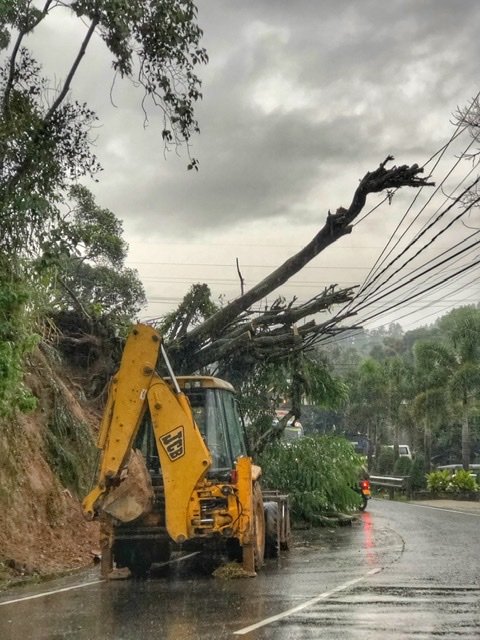
Upon arriving, we dodged eager to please tuk tuk drivers and ambled down the street from the train station toward our accommodation at, Every View Homestay ($9/night.) On the way we witnessed just how much rain had come down on the town just hours before our arrival. Landslides seemed to have plummeted into the road every 20’. At the turnoff for our accommodation, we ascended a 10-minute ridiculously steep, mucky mess of a path which nearly made us wipe out. Along the way we gazed alarmingly at the precarious nature of the houses that lined the rain soaked hillside, wondering if more landslides might be a worry.
Once we reached the top of the hill however we found Every View Homestay to be perched atop a stable rock outcrop; with a knockout view of Ella Rock, Ella Gap and the shockingly thunderous (now dirty brown) Rawana waterfall across the valley.
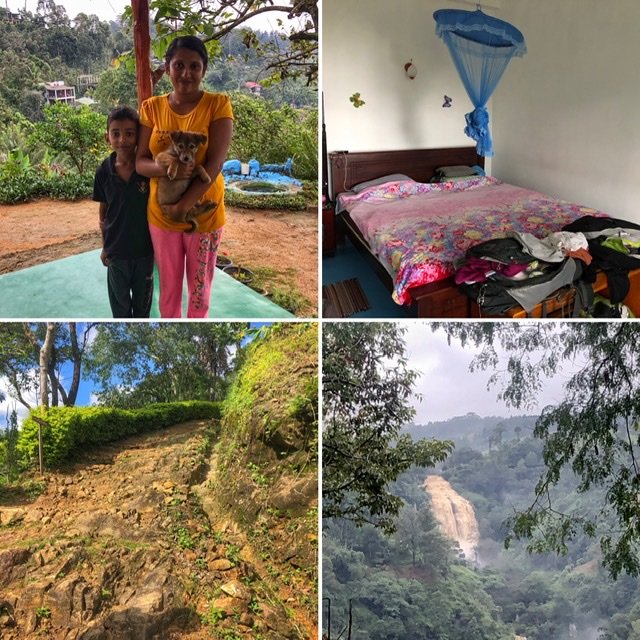
The “Every view” was so phenomenal we didn’t even mind not having power for half the night; it was an idyllic place for our three nights in Ella.
- Our sweet hosts and their playful pup, Roxi, at Every View
- The room
- The hill we climbed, which wasn’t too bad when it wasn’t downpouring!
- Rawana waterfall as it appeared the day we arrived.

After a night of sleeping to the sound of the roaring waterfall, back at Every View we enjoyed our full breakfast (naturally with a view,) which was included in our $9/night rate. It included fruits like papaya, pineapple and bananas, as well as fan cakes (which is basically a yellow sticky crepe) stuffed with a coconut and honey filling, and roti (coconut bread) with jam. We’re not usually big breakfast people, but Sri Lanka certainly turned us into them.
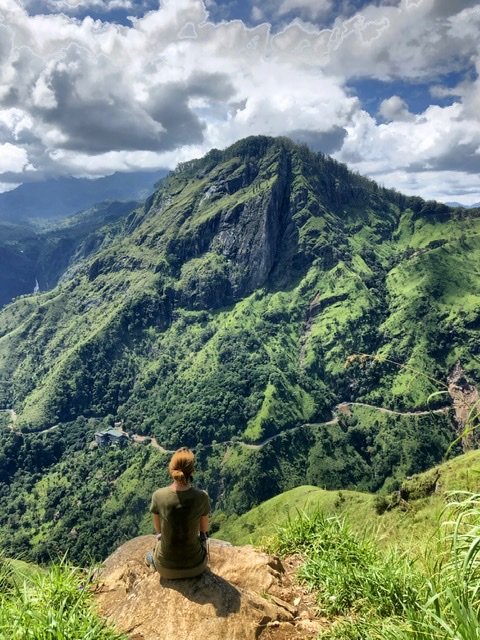
Ella is a walker’s dream. Due to the rain, we had one solid day of hiking enjoyment in which to visit Little Adam’s Peak and the Nine Arch Bridge. Little Adam’s Peak is a quick, but beautiful walk which takes about 2-3 hours. On it, you pass through rolling tea plantations with ladies plucking leaves in colorful saris and you get to catch glimpses of Ella from far and wide. If you’re feeling adventurous, there is a chance to do zip lining, abseiling and mountain biking at the top. We considered abseiling, because we’ve been wanting to try it, but when we saw the vertical wall of only about 10 meters, we decided that would be a ridiculous waste of cash.

One of the many tea plantations in Ella.

From Little Adam’s Peak, we ventured onward to Demodara Nine Arch Bridge which is apparently where all the tourists hang out. We didn’t time it very well so we didn’t get to see the magic of a train passing over.
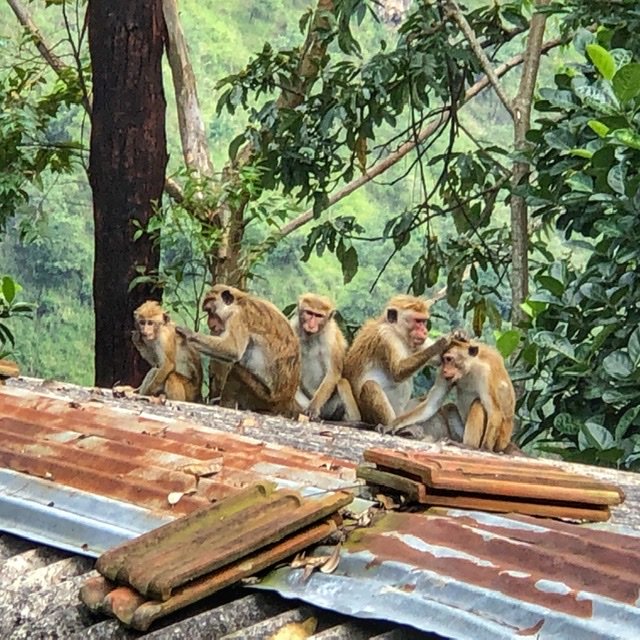
You never know what those naughty monkeys are going to be up to. Although these cuties were generally well behaved as they sat in a grooming train, in Ella we had an incident where we were in our room and heard massive screeching and hooting out of nowhere. Upon going outside we discovered the entire tree next to our place violently shaking with their vibrations. A massive alpha perched at the top flashed full fangs as a group of smaller monkeys attempted to climb their way up… all hissing and squalling to one another. The alphas also have a tendency to get on top of houses and vigorously shake weather vanes, wires and anything else they can get their hot-tempered little hands on.

The town of Ella is basically one street that winds its way from the train station down the hill. Here we checked it out with a traditional Lion Lager.

It’s definitely one of the most hopping places we visited in Sri Lanka full of nightly live music and a large helping of culinary options. We grabbed dinner at the Jade Green and couldn’t have been happier with our choice.

Our first deviled fish, a mouthwatering aromatic and spicy fish and veggie creation.
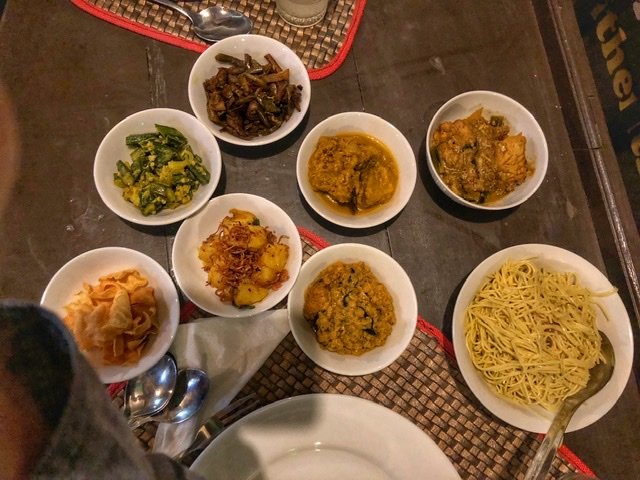
Rice & Curry mix. Another traditional Sri Lankan dish. Wow, the food is just divine in Sri Lanka. Where are all the Sri Lankan restaurant around the world?! Time to export!

We had two other firsts in the trees…witnessing our first giant squirrel. Quite actually…a giant squirrel. He was climbing about in a jackfruit tree, also a first.
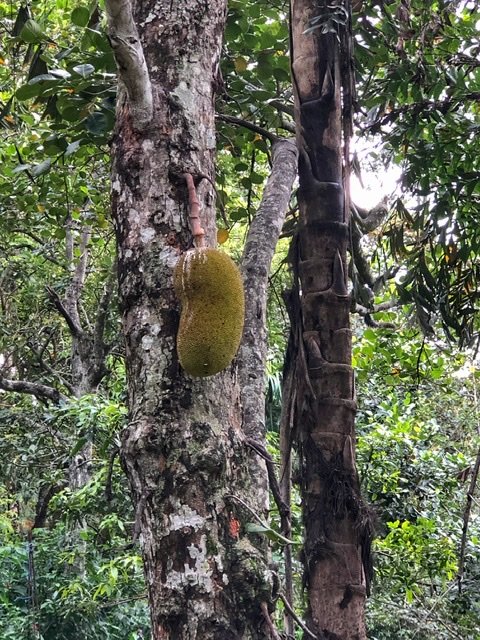
We actually weren’t sure if the alien cocoons draping from the tree was a durian or jackfruit as to us, they look pretty similar. But apparently, the jackfruit shell is much more smooth and knobby while the durian (this is the one that also makes your nose curl, emitting an odor of sweaty socks) is spiky.
Jackfruit is known as the “heavy weight champion of the tropics,” with the very largest fruits reaching nearly 50 kg (110 lb!). It’s often cooked and used in Sri Lankan rice and curry and has a very “meaty” like texture. Quite tasty! Not sure if we’re ready for a heaping bowl of it uncooked yet. It’s probably an acquired taste but sorta resembles rotten bananas or pineapple. Still…beats sweat socks!
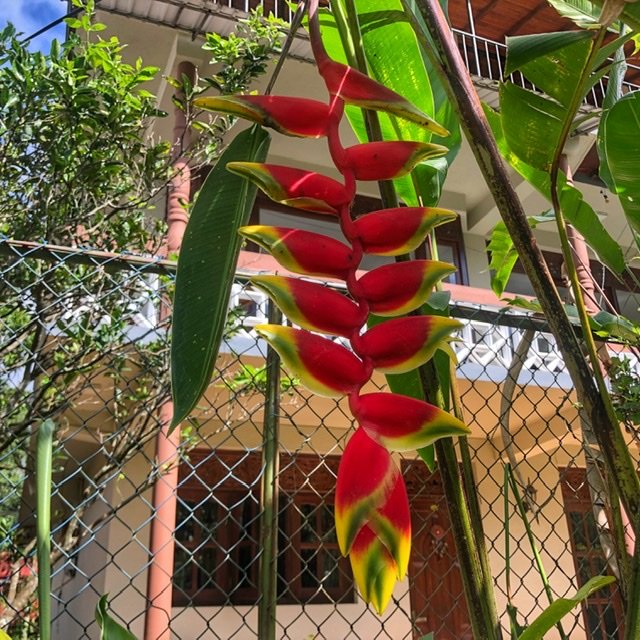
A beautiful, rare flower which we’d never seen. Simply growing in someone’s garden (draping over the contrasting ugliest fence!)
A wrap-up video of some of our favorite Sri Lanka moments. In the next post…Bundala National Park, Tangalle, south beaches, and Galle.




I am not going to die until I get to Sri Lanka. Maybe I’ll die while there since I’ll already be in heaven. This is your.ost amazing post out of all your amazing posts. I’m sure I won’t get Dennis to go to Sri Lanka before Uganda and that already puts us into late 2021. I’ll be 70! Love you guys. Stay safe and travel hard.
We love your list and that you keep pushing to see the things you most desire. 🙂 Uganda will definitely be amazing too and certainly on OUR list! thank you so much for the support and sweet comments!!
This was a lovely recap. The food, people, and culture sound amazing. Adding to our list! Also love the video clip at the end!!
Yeah, i thought you’d be adding to your list. Very good choice 😉